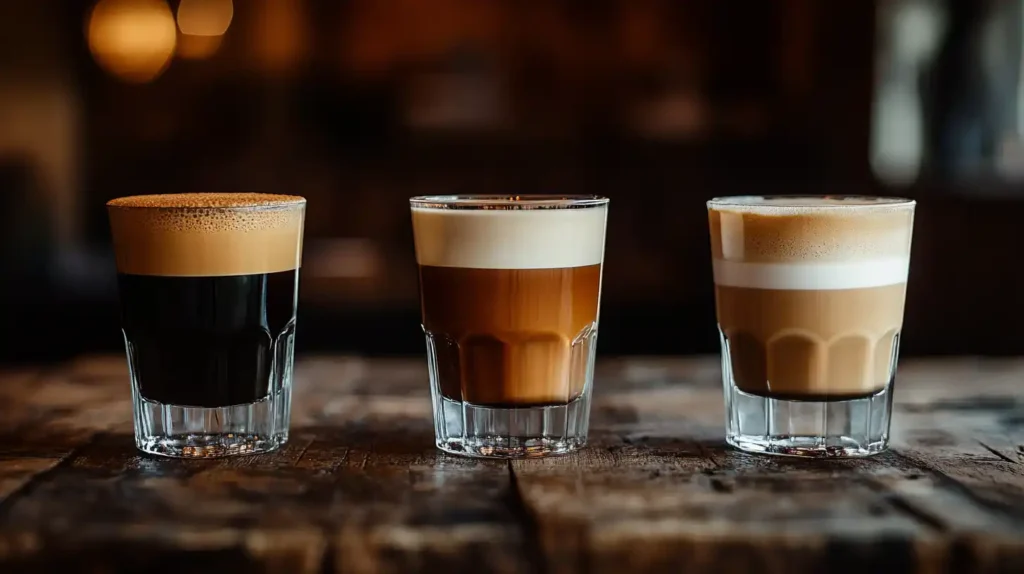Espresso, latte, and cappuccino each offer distinct coffee experiences through varying ratios of core ingredients.
- A classic espresso shot delivers pure, concentrated coffee flavor in roughly 1 ounce, topped with golden-brown crema.
- Lattes transform this foundation with a harmonious blend of 20% espresso, 60% steamed milk, and 20% foam, creating a smoother, creamier profile.
- Cappuccinos maintain a precise 1:1:1 ratio of espresso, steamed milk, and foam, striking a perfect balance between coffee intensity and silky texture.
The preparation techniques, milk temperatures, and precise measurements behind these classic beverages reveal the artistry of coffee craftsmanship.
Quick Summary
- Espresso is a concentrated shot (1 oz) of pure coffee, while lattes and cappuccinos build upon espresso with steamed milk additions.
- Lattes follow a 20:60:20 ratio of espresso to steamed milk to foam, creating a creamy, mild coffee experience.
- Cappuccinos maintain a distinct 1:1:1 ratio of espresso, steamed milk, and foam, delivering a perfectly balanced drink.
- Espresso showcases intense coffee flavors with crema, while milk-based drinks offer varying degrees of smoothness and creaminess.
- Temperature consistency matters across all three: espresso brews at 200°F, while milk steams to 150-155°F for lattes and cappuccinos.

The Classic Espresso Shot
An espresso shot serves as the foundation for most specialty coffee drinks, created by forcing pressurized hot water through finely-ground coffee beans.
This concentrated brewing method, typically using 9 bars of pressure at 200°F (93°C), extracts intense flavors and aromatic compounds in 25-30 seconds, producing approximately 1 ounce of liquid topped with a rich, golden-brown crema.
Unlike the Aeropress, which operates at a lower pressure of around 0.5 bars, a traditional espresso maker requires a higher pressure to achieve the desired flavor and texture. The hallmark of a properly pulled espresso is its complex flavor profile and distinctive three-layer composition.
The crema, a foam layer formed by emulsified oils, provides aromatic intensity and a slight bitterness. The body, the middle layer, delivers the primary coffee flavors and contributes to the drink’s rich mouthfeel. The heart, the bottom layer, adds sweetness and depth to the overall taste experience.
Quality espresso requires precise calibration of multiple variables: grind size (fine, consistent particles), dose (typically 18-21 grams), tamping pressure (30 pounds), water temperature, and extraction time.
When properly executed, the result is a concentrated coffee featuring bright acidity, full body, and intense flavors ranging from chocolate and nuts to fruit and caramel notes, all without any harsh bitterness.
Understanding Milk-Based Coffee Drinks
While espresso forms the powerful base of many coffee beverages, the addition of steamed milk transforms this concentrated shot into a range of distinctive drinks.
The art of creating milk-based coffee beverages relies heavily on the technique of milk steaming, which involves introducing hot pressurized steam to create microfoam – a velvety mixture of heated milk and microscopic bubbles.
The key components of milk-based coffee drinks include:
- Steamed milk: Heated to 150-155°F (65-68°C), creating a smooth, glossy texture
- Milk foam: Varying densities of aerated milk, from light and frothy to dense and creamy
- Temperature control: Critical for preserving milk proteins and achieving optimal sweetness
The transformation of milk through steaming produces distinct layers and textures, each contributing to the drink’s final composition. Professional baristas manipulate these elements through precise control of steam pressure, wand angle, and timing.
The proteins in milk denature during the heating process, creating new molecular structures that result in the characteristic smoothness and stability of properly steamed milk. This scientific approach to milk preparation distinguishes high-quality coffee drinks from their inferior counterparts.
Crafting the Perfect Latte
Creating the perfect latte demands a meticulous balance of espresso extraction and milk texturing techniques. Begin by pulling a well-calibrated double shot of espresso, ensuring optimal extraction time between 25-30 seconds with water temperature at 195-205°F.
The espresso should exhibit a rich crema and balanced flavor profile. Standard composition for a latte typically consists of 20% espresso, 60% textured milk, and 20% foam, so it’s essential to maintain this ratio when crafting the perfect latte.
For milk preparation, start with cold, fresh whole milk at approximately 40°F. Steam the milk to create microfoam, maintaining the steam wand at a 15-degree angle just below the surface. The ideal temperature range is 150-155°F, creating a silky texture with tiny, uniform bubbles.
The properly steamed milk should have a glossy appearance and velvety consistency. As you steam the milk, aim to create a whirlpool effect during steaming, similar to the technique used in traditional latte preparation.
Combine the elements by first pouring the espresso into a preheated 12-ounce cup. Then, integrate the steamed milk by starting from a higher position to allow the milk to sink beneath the crema. As the cup fills, lower the pitcher closer to the surface and increase pouring speed slightly.
This technique creates the characteristic latte art pattern while maintaining the drink’s signature 1:3 espresso-to-milk ratio. The final product should showcase a harmonious blend of robust espresso and creamy steamed milk.
Mastering Cappuccino Preparation
Mastering the perfect cappuccino requires precise attention to the traditional 1:1:1 ratio of espresso, steamed milk, and milk foam. This classic Italian beverage demands meticulous preparation techniques to achieve its signature balance and texture.
The foundation begins with pulling a quality espresso shot, typically 25-30 seconds for optimal extraction. It’s essential to note that a single shot of Espresso is 1 ounce, but a double Espresso is more common, at 2 ounces, and is often used as the base for a cappuccino Espresso basics.
The brewing temperature for the espresso shot should be between 195°F and 205°F for optimal flavor.
The steaming process is crucial for creating the distinctive cappuccino texture. Heat whole milk between 150-155°F (65-68°C), incorporating air during the initial phase to create micro foam. The goal is achieving a silky, paint-like consistency that seamlessly integrates with the espresso.
Key elements for cappuccino excellence:
- Maintain temperature control during milk steaming to preserve natural sweetness
- Position the steam wand at a 15-degree angle for optimal foam development
- Create a glossy microfoam with fine, uniform bubbles
Pour the steamed milk steadily into the espresso, allowing the microfoam to fold naturally into the drink. The final product should exhibit a harmonious blend of coffee intensity and creamy texture, topped with a smooth, dome-shaped layer of foam approximately 1 centimeter thick.
When properly crafted, the cappuccino presents distinct layers while maintaining its integrated character.
Choosing Your Coffee Experience
The selection of espresso-based beverages reflects a spectrum of distinct coffee experiences, each offering unique proportions and characteristics.
Understanding these differences enables coffee enthusiasts to align their choice with specific taste preferences and drinking occasions.
| Drink Type | Best For | Flavor Profile |
|---|---|---|
| Espresso | Intense coffee purists | Bold, concentrated, full-bodied |
| Latte | All-day coffee drinkers | Creamy, mild, balanced |
| Cappuccino | Morning ritual seekers | Rich, harmonious, textured |
| Flat White | Smooth coffee lovers | Velvety, coffee-forward, refined |
| Macchiato | Bold flavor enthusiasts | Strong, marked, distinctive |
When selecting between these beverages, consider both personal taste preferences and timing. Espresso delivers maximum coffee intensity in minimal volume, while lattes offer a more mellowed experience through higher milk content.
Cappuccinos strike a balanced middle ground with equal parts espresso, steamed milk, and foam. Time of day can influence the choice: traditionally, milkier drinks are favored in mornings, while pure espresso is often preferred after meals.
Climate considerations may also impact selection, with iced variations becoming increasingly popular for warm weather consumption.

